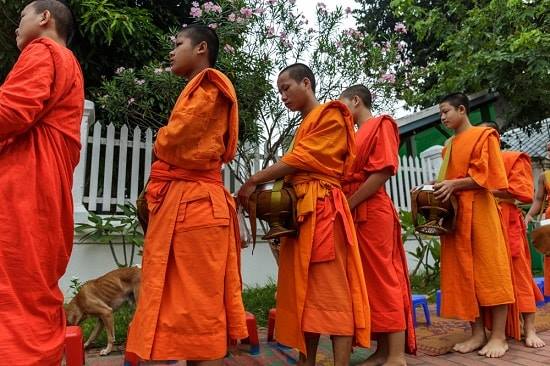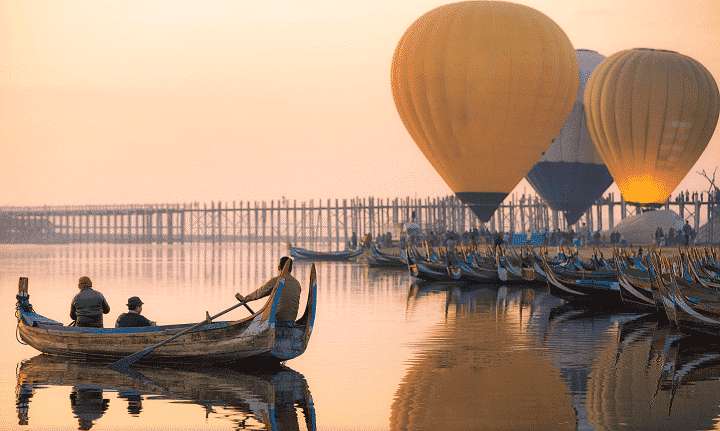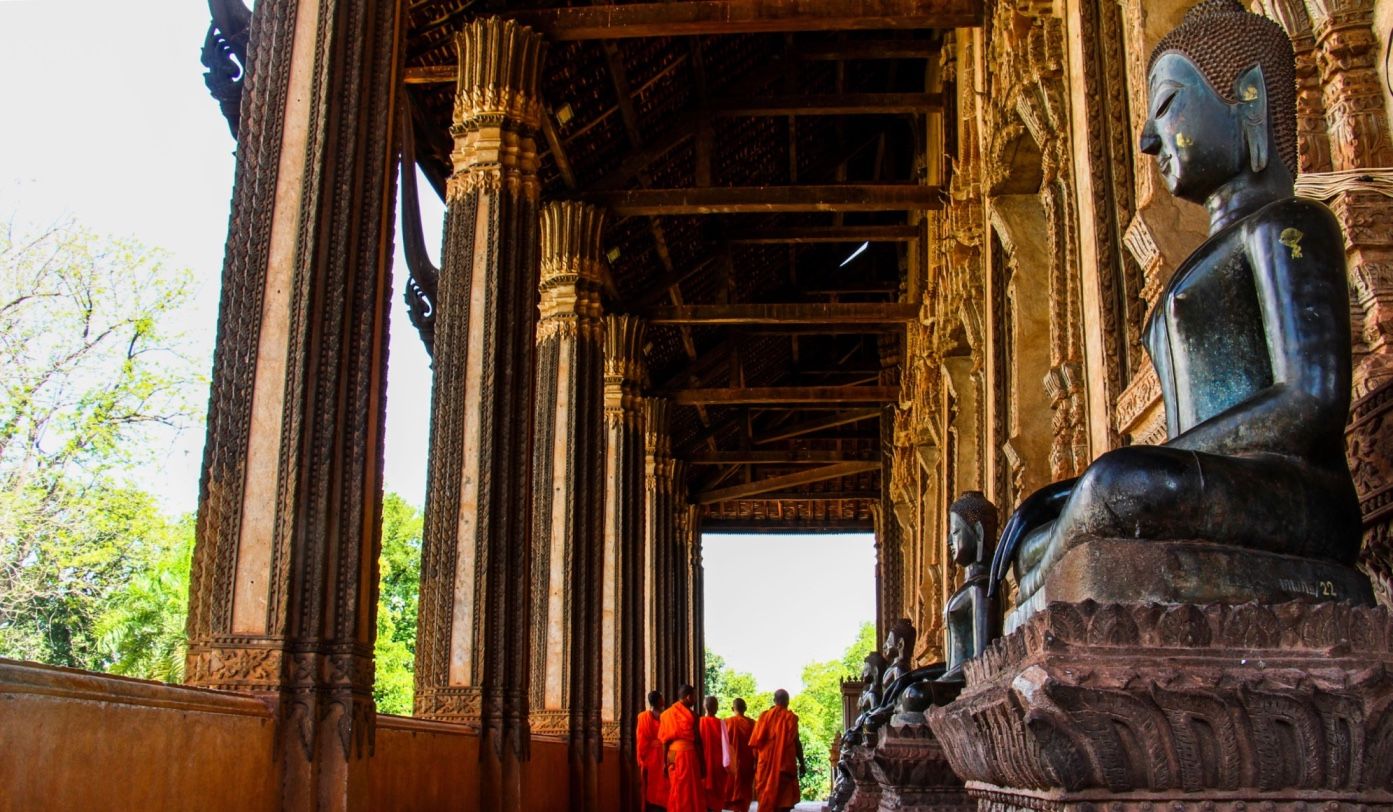LAOS CULTURE
Laos culture is unique, about 60% of the country, mainly the lowland Lao and a sprinkling of Thai tribes, are Theravada Buddhists. Every Lao Buddhist male is expected to become a monk for a short period of his life, usually between school and starting a career or getting married.
The main non-Buddhist culture and traditions surrounding ‘religion’ include phii worship, a spirit cult that is officially banned. Additionally, Hmong/Mien tribes practice animism and ancestral worship. Some also adhere to a Christian version of the cargo cult, believing that Jesus Christ will arrive in a jeep, dressed in combat fatigues.
Furthermore, a small number of Lao – mostly the French-educated elite – are Christians.
Everything about Laos Culture from A to Z
Laos is the least developed and most enigmatic of the three former French Indochinese states. A ruinous sequence of colonial domination, internecine conflict and dogmatic socialism finally brought the country to its knees in the 1970s, and almost 10% of the population left.
Furthermore, after a decades of isolation (If that matter), from the outside world, Laos, a landlocked, sparsely populated nation is enjoying peace, awakening from its socialist slumber and admitting foreign visitors.
The lack of foreign influence offers travellers an unparalleled glimpse of traditional Life and Culture in Laos.
Laos Facts at a Glance
Full country name: Lao People’s Democratic Republic
Area: 236,000 sq km
Population: 7.6 million (2024)
Capital city: Vientiane (pop 1 Million in 2024)
People of Laos: 50% Lao Loum (lowland Lao), 30% Lao Theung (lower-mountain dwellers of mostly proto-Malay or Mon-Khmer descent), 10-20% Lao Sung (Hmong or Mien high-altitude hill tribes) and 10-20% tribal Thais
Language: Lao and Lao dialects (closely related to Thai), French
Religion: 85% Buddhist, 15% animist and spirit cults
Government: Socialist republic
President: Thongloun Sisoulith
Prime Minister: Sonexay Siphandone
Discover & Book Amazing Things To Do At Exclusive Prices. Enjoy Laos Beyond Its Iconic Landmarks with Unique Activities. Explore Best Laos Tours & Trips
Environment Of Laos
Laos shares borders with Thailand, Cambodia, Vietnam, China, and Myanmar (Burma). Its topography features rivers and mountains, with the Mekong (Nam Khong) flowing the entire length of the country. This river not only offers fertile flood plains for agriculture but also delineates Laos’ border with Thailand and serves as its primary transportation route.
Laos’s 70% consists of mountains and plateaus. The Annamite Chain, bordering Vietnam, runs parallel to the Mekong for half the length of the country. The rugged mountains average between 1500-3000 metres in height, and at their southern extremity open up to form the Bolaven Plateau, a 10,000-sq-km area that produces mountain rice, coffee, tea and other high-altitude crops. The highest mountain is Phu Bia (2819 metres) in northern Laos.
Two-thirds of Laos country is forested and only 10% of the country is considered suitable for agriculture.
Given that topography, it is fortunate that Laos has one of the lowest population densities in Asia – around 22 people per sq km. Most of Laos population is settled along fertile river valleys, although there are many small tribes living in the hills.
The largest population centres, Vientiane and Savannakhet, are both in the Mekong River Valley; 85% of the population lives in rural areas.
Languages spoken in Laos
The official language of Laos is Lao, as spoken and written in Vientiane. As an official language, it has successfully become the lingua franca between all Lao and non-Lao ethnic groups in Laos. Everything about Laos Alphabet & Language
There are five main dialects in the country, each of which can be divided into further subdialects. All Lao dialects are closely related to the languages spoken in Thailand, northern Myanmar and pockets of China’s Yunnan Province.
Traditional culture of Laos
Traditional culture in Laos has been heavily influenced by various strains of Khmer, Vietnamese and Thai cultures. The lowland Lao share the same ancestry as many Thai tribes, so the similarities between Lao and Thai culture are especially strong.
This can be seen in Lao sculpture, classical music, dance-dramas and cuisine culture. Lao folk music is more indigenous, based around the khaen (a double row of bamboo reeds fitted into a hardwood sound box). Folk music is often accompanied by dancing or bawdy theatre.
The focus of most traditional arts in Laos focuses primarily on religious & includes wats (temples), stupas and several distinctively Lao representations of Buddha. The Lao remain skilful carvers and weavers, but traditional silversmithing and goldsmithing are declining arts.
Lao Food Culture
Rice and noodle based dishes form the foundation for all Lao meals, and cooks use fresh ingredients such as vegetables, freshwater fish, poultry, duck, pork, beef, or water buffalo in almost all dishes.
Lime juice, lemon grass, and fresh coriander provide the food with its characteristic tang, and various fermented fish concoctions season the food with salt.
Hot chillies, garlic, mint, ground peanuts, tamarind juice, ginger, and coconut milk season the dishes. Diners often serve themselves with an accompanying plate of lettuce, mint, coriander, mung-bean sprouts, lime wedges, or local basil to create their own lettuce-wrapped titbits.
Drinking
It’s best to buy bottled mineral water from supermarkets. Avoid tap water unless you boil it before drinking.
For those interested in drinking beer and alcohol in Laos, consider trying Beer Lao, or Lao rice whisky, considered the national drink; it’s potent, so handle it with care. Beer enthusiasts can indulge in Beer Lao, brewed from locally grown Jasmine rice by the Lao Brewery Company.
Moreover, Laos is renowned for its exquisite coffee, cultivated in the Bolaven Plateau, known as the ‘Golden Land’ of coffee in the southern region of the country.
Events & traditional festivals in Laos
In Laos culture, festivals and traditional events are typically linked with agricultural seasons or historical Buddhist holidays.
The Lao lunar new year begins in mid-April and the entire country comes to a halt and celebrates. Houses are cleaned, offerings are made in wats and everyone gets dowsed by water.
Bun Bang Fai (the rocket festival) takes place in May. It’s an irreverent pre-Buddhist celebration with plenty of processions, music and dancing, accompanied by the firing of bamboo rockets to prompt the heavens to send rain.
The week-long That Luang Festival in Vientiane in November has the whole repertoire of fireworks, candlelit processions and music. In addition, all those events are heavily decorated with Dok Champa Flower
A glimpse into history of Laos
Laos has long been occupied by migrating Thais (including Shans, Siamese and Lao) and slash-and-burn Hmong/Mien hill tribes.
The first Lao principalities were consolidated in the 13th century following the invasion of south-west China by Kublai Khan’s Mongol hordes. In the mid-14th century, a Khmer-supported warlord, Fa Ngum, combined a number of scattered principalities around Luang Prabang to form his own kingdom, Lan Xang (‘a million elephants’).
The kingdom initially prospered, but internal divisions and pressure from neighbours caused it to split in the 17th century into three warring kingdoms centred on Luang Prabang, Wieng Chan (Vientiane) and Champasak.
By the end of the 18th century, most of Laos’ culture was influenced under Siamese (Thai) suzerainty. However, the territory was also facing pressure from Vietnam.
Unable or unwilling to serve two masters, Laos went to war with Siam in the 1820s, a disastrous ploy that led to all three kingdoms falling under Thai control.
Subsequently, by the late 19th century, France had established French Indochina in the Vietnamese provinces of Tonkin and Annam.
The Thais eventually ceded all of Laos to the French. Consequently, the French were content to use the territory merely as a buffer between their colonial holdings and Siam.
Laos During WW II
During World War II, the Japanese occupied Indochina, leading to the formation of a Lao resistance group, Lao Issara, aimed at preventing the return of the French.
Furthermore Laos achieved independence in 1953, but conflict persisted among royalist, neutralist, and communist factions.
In 1964, the USA escalated conflict by bombing North Vietnamese troops on the Ho Chi Minh Trail in eastern Laos, thereby heightening tensions between the royalist Vientiane government and the communist Pathet Lao, who fought alongside the North Vietnamese.
By the time a ceasefire was negotiated in 1973, Laos had earned the dubious distinction of enduring the most bombings in the history of warfare.
Following the formation of a coalition government, most royalists left for France when Saigon fell in 1975.
Furthermore, the Pathet Lao peacefully assumed control of the country, establishing the Lao People’s Democratic Republic in December 1975. Laos maintained a close alliance with the Vietnamese communists throughout the 1980s.
In addition to the closure of many private businesses after 1975, rules have relaxed since 1989, facilitating a transition towards a market economy that has spurred a small-scale economic revival. Since then, Laos culture and traditions have begun shaping a new era.
Laos Etiquette Tips
Laotians exhibit hospitality and friendliness, often displaying smiles at any occasion. Life here maintains a slow and relaxed pace.
Etiquette tips for visiting Laos include wearing modest clothing at temples and religious sites. When greeting Laotians, use the ‘Nop’ gesture, joining hands in a praying gesture up to chin level.
Always use your right hand to pass items. Lao Buddhist monks generally avoid physical contact with females, so place items nearby rather than handing them directly.
Moreover, touching someone’s head is taboo and considered highly insensitive in Laotian culture, as the head is viewed as the most important part of the body.
In hotels and restaurants in Laos, tipping is not customary nor expected.
Copyright 2013-2017 Vietnamese Private Tours Ltd With Vietnam Luxury Travel







